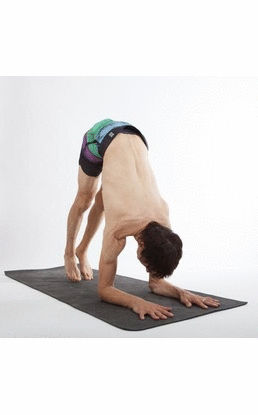
Karandavasana is one of the Second Series top 3 most challenging postures and like all asanas there is a progression. One of the first steps is being able to smoothly, rapidly, and dynamically execute the inverted padmasana.
I have provided you with 5 new Asana Kitchens that will help you develop this dynamic gesture. BUT the first requirement to begin studying any of the videos is to have a strong Pinchamayurasana. If you want tips on how to develop that posture I have fully broken it down on my Second Series dvd.
1) Padmasana in Shoulderstand
"To be able to perform more advanced postures like Karandavasana or Urdva Kukutasana, it is helpful to be able to dynamically flip the legs one after the other into Padmasana. The gesture of the flip promotes hip strength and flexibility. It may seem more difficult at first but with practice you will get the knack and skill of it. The flip will eventually help you to balance in the more advanced asana's with more ease. You can practice this move when you take Urdva Padmasana during your time in shoulder stand. The main key is to understand the frog like, external rotation of the legs and the satisfying thrill of the dynamism in the move."
2) Padmasana in Forearm Balance Headstand using wall
"Using the wall provides you an excellent safety net so that you can freely and fearlessly attempt to create the flip gesture that achieving this position calls for. Remember to externally rotate your legs before flipping, make like a frog, and then feel the circular action in the joint as you dynamically swing one leg at a time into lotus. Use the wall to show you how to stay in the vertical line rather than attempting to take the lotus with the legs too far behind (towards the wall) you. For faster results realistically pretend that the wall is not there!"
3) Padmasana in Pinchamayurasana using wall
"Learning to take Padmasana in Pinchamayurasana while using the wall for support is an excellent preparation for Karandvasana. Make sure you set your foundation all the way at the wall so that you can work with as close to a vertical body position as possible. Refrain from over using the wall, don't lean back too far or too easily. If you must touch the wall do it with one foot only while continuing to maintain the vertical line throughout the rest of the body. Try many times minimizing your use of the wall in order to gain strength and stamina."
4) Padmasana in Forearm Balance Headstand
"This video presents how to take Padmasana from a forearm balance headstand without the wall as a preparation for Karandavasana. Remember to maintain a true vertical position over your foundation as you work on this move. Once you flip the first leg remember to lift up that knee and push it back in order to successfully flip the second leg to complete the position. Alternate the leg that you start with to facilitate symmetry between the two sides. Think of your forearms, shoulders, and upper back as the foundation more than your head. Press into your foundation and also lift vertically up out of that foundation."
5) Padmasana in Pinchamayurasana - Karandavasana
"Successfully taking Padmasana from a free standing forearm balance represents a significant step along the way to achieving Karandvasana. Establish a clear, rock solid foundation before you kick up. Achieve and maintain as true a vertical line as possible when attempting to fold the legs into lotus. Do your best to swing the legs dynamically by externally rotating your legs circular fashion with the nimbleness of a frog. Practice diligently to acquire the knack of the flip so that you'll have energy to spare for lowering your legs onto your arms in the next step of the posture."
Comments
No comments.